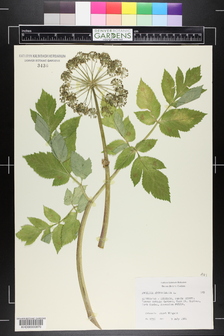Back to Tour: Medicinal Plants Tour
|
Angelica archangelica Garden Angelica; Archangel; Wild Parsnip |
Denver Botanic Gardens
Gardens Navigator 
|
|
Accession Number: 680204*1 Map | Image | |
| More about Angelica archangelica | |
| TOUR DETAILS |
Medicinal uses: Angelica has digestive and antispasmodic properties, helping promote secretion of gastric juices effective in treating loss of appetite. It also has sedative properties. Angelica has been known to be a diuretic and expectorant helping to combat colds. Studies show that angelica is good at improving blood flow, which makes it a treatment against Beurger’s disease. Pregnant women should not take angelica as a medicine as it has negative effects on pregnancy. Mythology/Folklore: There are many stories as to how the plant is named Angelica. One legend tells that during the time of the Bubonic plague, angel Gabriel showed the plant to a wise man as a cure. Another story features an unnamed angel appearing to a monk in a dream and revealing to him that the plant would help cure the plague. A nickname for this plant is the “Root of the Holy Ghost.” The plant was also believed to be a great defense against evil spirits. Currently, angelica is used to create chartreuse liquor. Because the majority of the 25 species of angelica are poisonous, the plant is risky to collect in the wild. Medicinal recipe: Candied Angelica: 1 cup sugar, 1 cup water, ½ pound thick green angelica stems, cut into 3- to 8-inch lengths; sugar for dusting. Bring the sugar and water to a boil. Remove the pan from the heat. Bring a different pan of water to a boil. Add angelica stems. Over medium-high heat, cook stems for 4 to 6 minutes. Drain stems, rinse them in cold water, and drain them again. Peel off the thin skin. Put the stems into a bowl, pour the syrup over them. Leave them there overnight. The next day, drain off the syrup into a saucepan. Boil it until it has has thickened and pour it over the angelica. Repeat this process for two days. The next day, pour off the syrup, and boil it to 230 degrees Fahrenheit. Add the angelica stems and bring the syrup back 230 degrees. Drain stems and then place them on a rack in a warm place until they are dry to the touch. Dust dried stems with sugar and store them in an airtight container. Culture: (from Loddie Dolinski, staff horticulturalist) The plant is a biennial, so the first year it's a rosette and the second is a main stalk whic spreads lots of seed. Angelica can be grown in partial shade to sunny and needs a good amount of water to grow. |
| LOCATION GROUP | Herb Garden |
| FAMILY NAME | Carrot Family |
| FAMILY | Apiaceae |
| ACCESSION DATE |
March 15, 1968 (When this plant was acquired and registered in the database) |
| FLOWER COLOR | white |
| USDA HZ | 4 (Coldest Zone Where Hardy) |
| HABIT | Herbaceous (Non-woody) |
Location Map for 680204*1 Angelica archangelica
Map Help
Flowering
When Angelica archangelica has been observed flowering at Denver Botanic Gardens
 | ||||||||||||||||||||||||||||||||||||||||||||||||||||
| 2015 |  |
 |
 |
 |
 |
 |
 |
 |
 |
 |
 |
 |
 |
 |
 |
 |
 |
 |
 |
 |
 |
 |
 |
 |
 |
 |
 |
 |
 |
 |
 |
 |
 |
 |
 |
 |
 |
 |
 |
 |
 |
 |
 |
 |
 |
 |
 |
 |
 |
 |
 |
 |
| 2013 |  |
 |
 |
 |
 |
 |
 |
 |
 |
 |
 |
 |
 |
 |
 |
 |
 |
 |
 |
 |
 |
 |
 |
 |
 |
 |
 |
 |
 |
 |
 |
 |
 |
 |
 |
 |
 |
 |
 |
 |
 |
 |
 |
 |
 |
 |
 |
 |
 |
 |
 |
 |
| 2006 |  |
 |
 |
 |
 |
 |
 |
 |
 |
 |
 |
 |
 |
 |
 |
 |
 |
 |
 |
 |
 |
 |
 |
 |
 |
 |
 |
 |
 |
 |
 |
 |
 |
 |
 |
 |
 |
 |
 |
 |
 |
 |
 |
 |
 |
 |
 |
 |
 |
 |
 |
 |
Images © Denver Botanic Gardens
 680204*1 Angelica archangelica Flower|Leaf |

© Denver Botanic Gardens, 1007 York Street, Denver, CO 80206
Photography © Denver Botanic Gardens

Powered by







 E-mail
E-mail